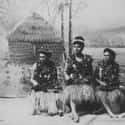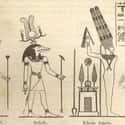-
(#11) Kathoey - Thailand
Thailand holds a status as a country famous for its acceptance of different sexual identities. But the roots of the kathoey, or "lady boy," tradition go a lot deeper than most people may realize. Thailand is a primarily Buddhist nation, and Buddhism actually recognizes four distinct genders, and from one of those four comes the "kathoey." Kathoey are typically transgender women, though not all trans women see themselves as kathoey. It's deeply tied to spirituality and religion, which is why some trans women choose not to identify as kathoey.
They are generally accepted in most major cities, and at least tolerated in smaller villages. In some instances, citizens consider kathoey to be a form of karma, resulting in their respect as everyone will go through one of their lives as kathoey. The kathoey are also viewed as conduits for both male and female spirits, lending them sometimes statuses of high regard in Thai society.
-
(#6) Xanith - Oman
Oman remained isolated from the world until the 1970s, and because of this solitude the country formed a slightly different view of sexuality than its neighbors. They recognize a third gender known as Xanith, which refers to a man who behaves like a woman and plays the passive role in homosexual relationships.
Because of this behavior, Xaniths are subject to the same laws of society that apply to women. They are not allowed to cross dress, but they dress in a similar fashion as women and frequently operate as sex workers.
-
(#1) Wakashu - Japan
Also known as "beautiful youths," the wakashu of Japan emerged as a widely accepted third gender during the Edo period. The wakashu were generally adolescent boys who were androgynous in appearance and behavior. Woodblock prints of the time depicted them as playful, sensual, and feminine.
Japanese culture portrayed them to be objects of desire for both women and men, at least until Western culture became more prominent and the tradition slowly faded away.
-
(#2) Māhū - Hawaii
In native Hawaiian culture, Māhū means someone who embodies both male and female spirits. Instead of identifying more as a male or more as a female, they accept both equally and see gender as a beautiful, flowing thing. More than just accepted in Hawaiian society, Māhūs are revered, their fluidity considered an empowering force.
Instead of viewing their "differentness" as a problem, they see their dual-spirits as a way to navigate life's challenges with grace, a true liberation.
-
(#7) Sḫt (Sekhet) - Egypt
One of the oldest known examples of a third gender come from Egypt . Pottery shards from between 2000 and 1800 BCE depict three distinct genders - male, female, and sekhet , which was neither male nor female.
The drawings of the male and female characters both include anatomically correct privates, but the sekhet drawing appears to be a man with no member.
-
(#5) Khawaja Sira - Pakistan
Individuals in Pakistan who identify as Khawaja Sira occupy a complex place in society - they simultaneously receive praise as being "gifted by god" but also face intense discrimination. Khawaja Sira individuals are usually rejected by their families, but form their own family trees through their system of gurus and apprentices.
Although Pakistan has been slow to embrace the modern transgender movement, their traditional Khawaja Sira gender identity remains an ancient custom; their religious devotion led the Hindu deity Ram to declare the Khawaja Sira the final rulers of the human race.
New Random Displays Display All By Ranking
About This Tool
The history of the third gender has been very long and this topic has always been extremely controversial. Since ancient times, humans have always divided gender into two different. In fact, there are more genders than we recognize or express. As early as January 2013, the Nepalese government agreed to issue a third-gender identity card, which makes life more convenient for sexual minorities in Nepal. Germany has also become the first country in Europe to recognize the third gender.
More and more countries have introduced relevant policies and laws to protect the equal rights of people with different gender perceptions, which is the next level interpretation of freedom and human rights. Here you can know more about the third gender from cultures in different countries.
Our data comes from Ranker, If you want to participate in the ranking of items displayed on this page, please click here.
















